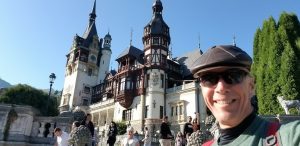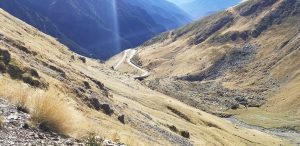By Page H. Gifford
Correspondent
 Recently, world travelers Al and Sue Mink traveled to Romania and lived three months in Bucharest.
Recently, world travelers Al and Sue Mink traveled to Romania and lived three months in Bucharest.
“Romania, more than any other country they visited, still had the scars of Communism. Bucharest would be described as a gritty city – a strong, powerful character under a rough and tumble exterior,” she said.
At one time, Bucharest was a very beautiful city. It was known as Paris of the East. Sue described the spectacular examples of turn of the century Parisian style architecture. Parisian style and influence had been seen in many eastern European countries throughout the 18th and 19th centuries.
“Much of the city was razed during the Communist era, and there are large sections of rather heartless communist buildings, and many of the beautiful buildings that remain still need to be renovated. But there are hopeful signs.”
They lived right in front of Bucharest’s spectacular fountains, which have a sound and light show three times every weekend. Impressed with their cultural offerings, she and her husband Al attended the opera for the first time in their lives and were surprised that they loved it. With a talented cast of over 60, a full orchestra, and the best seats in the house, the opera cost under $19.
“Romania is working hard to preserve their folk culture which is very rich in crafts, architecture, and music. I had read that people had visited Bucharest and hated it – but it’s a city that you have to immerse yourself into. Once you understand the history, the culture and the past hardships of the people there, it’s a fascinating place.”
Sue says the best part of Romania is the Transylvania region and it’s not all about vampires. Romania has had a brutal history. They were the victims of many invasions and when they weren’t being invaded, it seemed they were suffering plagues. A result of the many invasions is a very diverse and rich culture that’s a melting pot of the many cultures that ruled there over time. In the mid-12th century, the residents invited the German Saxons to settle there in order to help the fight against the Ottoman Turks.
“Transylvania looks very German. Even the church services there (Lutheran in what used to be Catholic cathedrals) are still in German.” Some of the places that caught the Mink’s attention were the fortified churches in Transylvania. She explained that because the region was invaded so often, the towns, instead of walling the entire village, would just wall the area around the church. Inside the wall were rooms for the villagers to stay during a siege, like a little condo! They also had bakeries, blacksmiths and even a school.
“Many are in ruins, but many are renovated and are fascinating places to visit.”
She describes the cities as clean, renovated and the German architecture still intact. “It’s the area most tourists visit, and with good reason. It’s like traveling through Bavaria for a quarter of the price, with the added benefit of the rich Romanian culture.
Near the town of Sinaia, is the striking Peles castle built by the first king of Romania, who was German.
“It’s probably the most beautiful castle I’ve ever seen and one I’d be happy to live in, too, as it was built in 1883 and has electricity, an elevator, and even a central vacuum cleaning system.”
She said another spectacular sight in the Transylvania region was the Transfagarasan Highway, built by the dictator Ceausescu in the early ‘70s.
 “It stretches 56 miles over some of the most forbidding landscape you can imagine building a road on. It is only open from June 30 to October 30 due to landslides and snowfall, and is a spaghetti pot of a road winding up and down a spectacular mountainside, much of it above the tree line.” They drove it twice, and Al rode his bike on it once and every time they encountered a bear. She adds that the guys from the British TV show “Top Gear” have christened it the best driving road in the world, but that’s if you love hairpin turns without guardrails.
“It stretches 56 miles over some of the most forbidding landscape you can imagine building a road on. It is only open from June 30 to October 30 due to landslides and snowfall, and is a spaghetti pot of a road winding up and down a spectacular mountainside, much of it above the tree line.” They drove it twice, and Al rode his bike on it once and every time they encountered a bear. She adds that the guys from the British TV show “Top Gear” have christened it the best driving road in the world, but that’s if you love hairpin turns without guardrails.
In contrast to its historic and natural beauty, Sue says poverty is evident in Romania. The Roma (Gypsy people) are about four percent of the population and being in the minority, they face discrimination and hardship.
“Many people in rural Romania don’t have plumbing and you have to be careful on the roads, even the highways because many people still only have horse carts. There are beggars on the streets in Bucharest, many in desperate need of medical attention. Lots of buildings are abandoned and in disrepair – the result of the rapid fall of communism.”
She mentions the food, some familiar to Americans and brought over by immigrants including Hungarian goulash and Turkish baklava, German sausages and Croatian mici (little spiced meat “fingers”).
In 1866, Romania had its first king, Carol I, from Germany but ruled the country independent from Germany. Romania had four kings up until Communist rule.
“That time was considered the golden age for Romania. These kings were very wealthy and they put a lot of money into Romania, building palaces, universities, theaters, schools, and hospitals,” she said. “After WWII, Romania became Communist, much to the surprise of the people. They truly expected to be liberated by the West, but that never happened. They remained under Communist rule until 1989.” Those who know their history will recall Romania’s brutal dictator, Nicolae Ceausescu, who enforced a strict austerity regime on the people while he lived in luxury. “His goal was to totally pay off Romania’s national debt, which he did, but at great suffering of his people. People had to wait in line for hours for basic foodstuffs and people even died of starvation. Speech was strictly curtailed and there were thousands of political prisoners. The 1980s were especially harsh. The people finally had enough and rose up in revolt on December 21, 1989, during a speech by Ceausescu in Bucharest. He and his wife tried to escape by helicopter but were captured and were executed on national TV on Christmas Day that year.”
“The government underwent a quick reconstruction and is still working to improve things but there is still a lot of corruption, but the government is working very hard to establish a respect for rule of law and the understanding that no one is above the law of the land. After a dictator like Ceausescu, where the people saw what could happen when a national leader didn’t respect the law, it is a very welcome change.”
The People’s Palace, she said, is an ode to Ceausescu’s ego. While his people were starving, he built this huge government building, the second largest in the world that rivals the Pentagon in size. It was only two blocks from their apartment.
“It wasn’t finished in 1989 when Communism fell, and it was so hated that people discussed tearing it down, but it would have cost more to do that then to finish it, so they did. Now, besides housing the government, it is the site for conventions, concerts, and while we were there, a pretty awesome wine festival.”
Another interesting site was The Therme, the largest spa in Eastern Europe.
“It’s incredible. It has a huge indoor-outdoor pool with a forest of palm trees growing around it, numerous saunas and steam rooms, and a water-slide area with about 15 waterslides, one of them was four stories tall. All of this for about $25 for the entire day.”
She said that many Romanians were concerned about how Americans viewed them. “There is a reputation for rudeness and unfriendliness, but we didn’t find it accurate. You had to remember that during the communistic rule, you could be jailed for simple comments and complaints, and so people learned to keep to themselves. However, once you “break the ice” we found the people to be warm, exuberant and welcoming.” She adds that invitations to a Romanian home meant that you’d spend the entire day there, often late into the night. “The people, despite hardship, were generous and fun-loving. You won’t get smiles from strangers on the street, but once you get to the point of conversation, you’ll find warmth and friendliness.”
One of the great things about Romania is that it’s really, really inexpensive. You can eat a businessman’s lunch at a well-known tourist restaurant for about $6 and it’s five courses. It’s even cheaper in Transylvania. While Bucharest may be a challenging city for those who haven’t traveled a lot, Transylvania is a beautiful, fascinating and very affordable choice for a great vacation.




